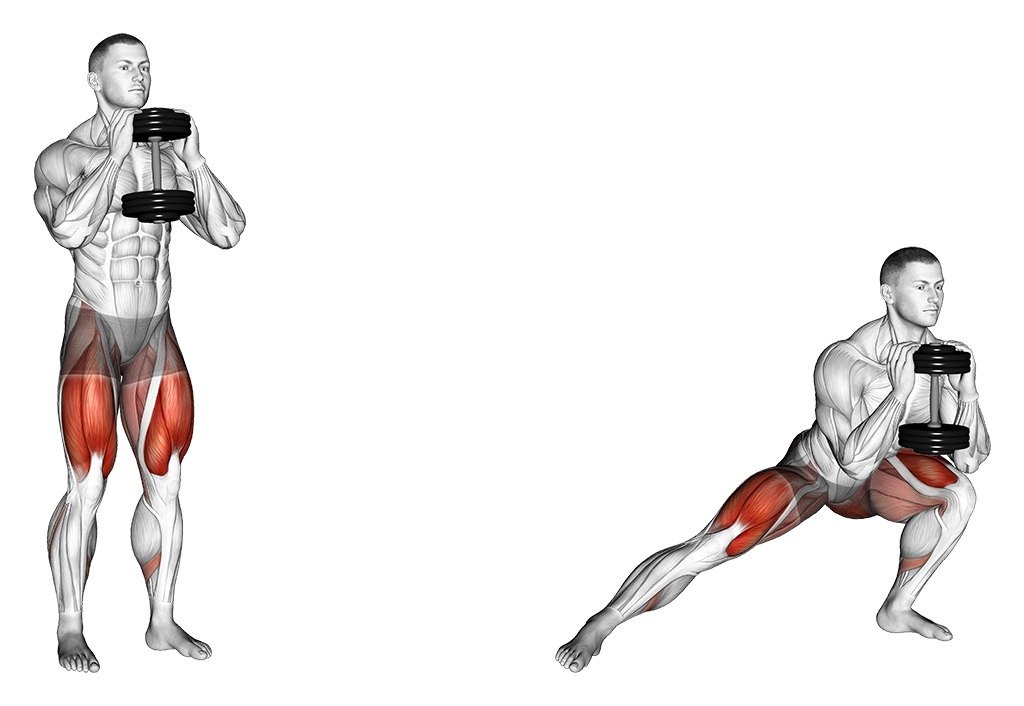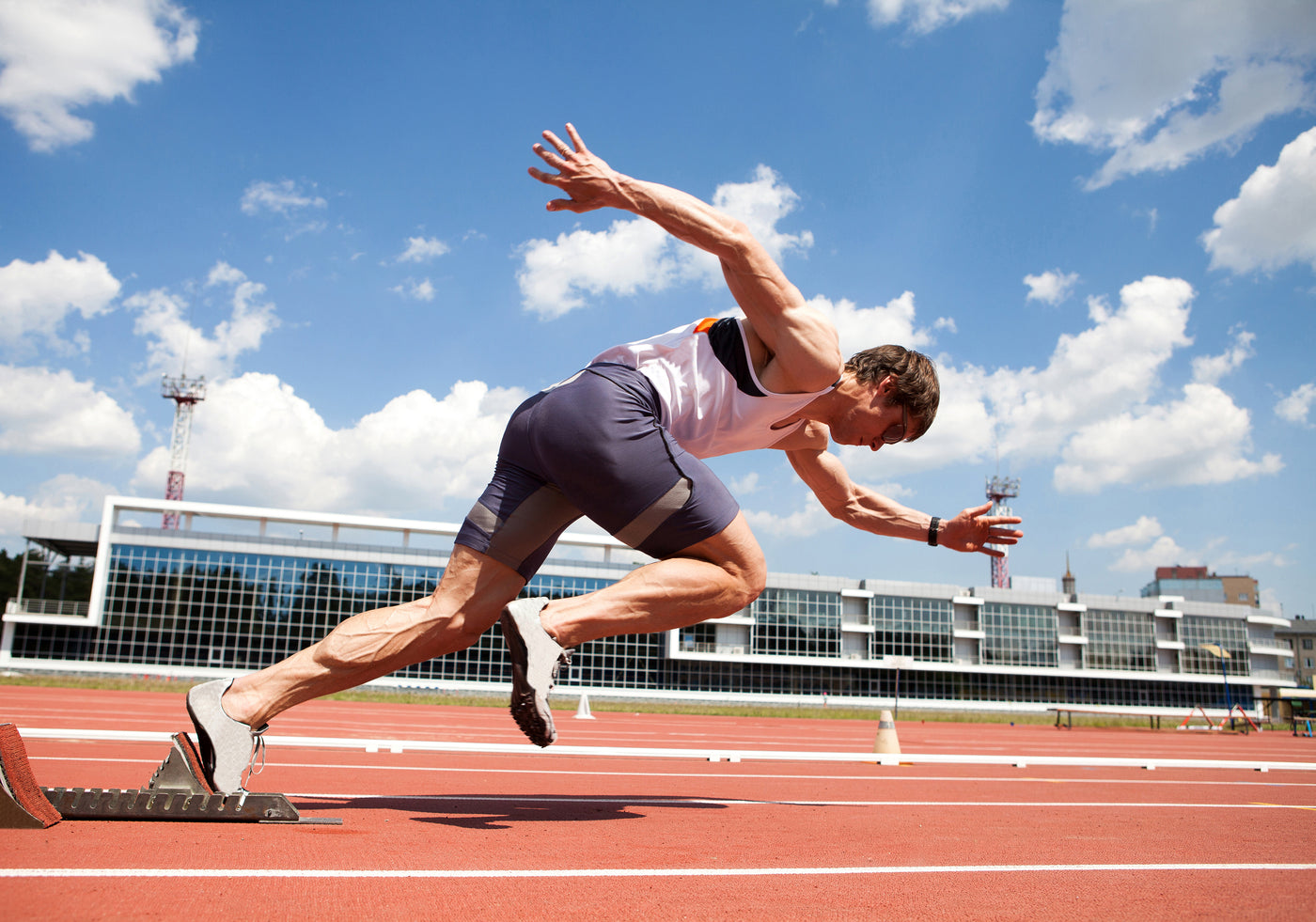Exercise Anatomy
Side Lunge
Diversify your lower body workout with the Side Lunge - a dynamic exercise that targets your inner and outer thighs. This lateral movement not only strengthens your legs but also enhances hip flexibility. Simple yet effective, the Side Lunge adds a refreshing dimension to your routine, promoting balance and functional strength. Spice up your leg day and embrace the benefits of this versatile exercise.

Major Muscles and Actions Involved
The Side Lunge, a lateral movement exercise, revolves around the joint actions of hip abduction and adduction. As you step to the side, the hip abducts, moving the leg away from the midline of the body. Upon returning to the starting position, the hip adducts, bringing the leg back toward the midline.
Engaging in Side Lunges activates several key muscle groups. The quadriceps work dynamically to extend the knee during the lateral movement. Simultaneously, the adductors, situated on the inner thigh, and the abductors, located on the outer hip, contribute significantly to the side-to-side motion. The gluteus medius and gluteus minimus, responsible for hip abduction and stabilization, play a vital role in maintaining balance throughout the exercise.
Moreover, the hamstrings, located at the back of the thigh, engage to stabilize the knee joint during the Side Lunge. The emphasis on lateral movement also challenges the muscles of the core, including the obliques, as they work to stabilize the torso during the side-stepping action. In essence, the Side Lunge provides a holistic lower-body workout, targeting various muscle groups to enhance strength, flexibility, and balan

Sports Uses
The Side Lunge, with its lateral movement pattern, proves to be a valuable exercise offering direct benefits in a variety of sports, enhancing both strength and agility.
In sports like tennis and badminton, where lateral movements are essential for swift court coverage, the Side Lunge becomes a valuable training tool. Athletes can strengthen the muscles involved in side-to-side motions, such as the abductors and adductors, enabling them to react quickly to opponents' shots and cover the court with agility.
Basketball players, known for their lateral movements during defensive plays and quick cuts on the court, incorporate Side Lunges to improve hip stability and strengthen the inner and outer thighs. This targeted training contributes to better lateral acceleration and deceleration, essential skills in basketball.
Skiers and snowboarders find direct benefits in the Side Lunge for enhancing leg strength and stability. The lateral strength developed through this exercise aids in maintaining balance and control while navigating slopes and executing sharp turns on the snow.
In martial arts, particularly disciplines that involve lateral footwork and defensive maneuvers, the Side Lunge is a valuable addition to training routines. It helps martial artists develop the necessary strength and flexibility for effective side-stepping and quick directional changes during sparring.
For athletes engaged in soccer, the Side Lunge proves beneficial for strengthening the muscles involved in lateral movements and cutting maneuvers. The exercise contributes to improved agility and stability on the field, assisting soccer players in changing direction rapidly and maintaining control over the ball.
Moreover, in activities like dance, the Side Lunge plays a role in building the leg strength and flexibility required for various choreographed movements that involve lateral shifts and transitions.
Incorporating the Side Lunge into training regimens across these sports provides athletes with a targeted approach to improving lateral strength, enhancing agility, and minimizing the risk of injuries associated with side-to-side movements. Its versatility and effectiveness make it a go-to exercise for those aiming to elevate their performance in sports that demand lateral mobility.
Exercise Tips
- Technique:
When performing Side Lunges, prioritize proper technique to maximize effectiveness and minimize strain. Ensure a wide stance, shift your hips back, and bend the knee of the lunging leg while keeping the opposite leg straight. Maintain an upright torso throughout the movement, engaging your core for stability. - Range of Motion:
Embrace a controlled and comfortable range of motion in the Side Lunge. As you step to the side, lower your body until your lunging thigh is parallel to the ground or as far as your flexibility allows. This full range engages the inner and outer thighs, optimizing the benefits of the exercise. - Amount of Weight Used:
Start with a moderate amount of weight, especially if you are new to Side Lunges. Focus on mastering the movement pattern before adding additional resistance. Gradually increase the weight as your strength improves, ensuring that you can maintain proper form throughout the exercise. - Variations:
Explore variations of the Side Lunge to target different muscle groups and add variety to your workout routine. Consider incorporating lateral lunges with dumbbells, side lunges with a lateral raise, or incorporating a medicine ball for an added challenge. These variations provide diverse stimuli, preventing workout plateaus and promoting overall leg strength. - Breathing:
Establish a consistent breathing pattern to enhance stability and focus during Side Lunges. Inhale as you step to the side and lower your body, exhale as you push off and return to the starting position. Maintaining rhythmic breathing supports core engagement and overall control throughout the exercise.
Side Lunge vs lunge
Side Lunge:
1. Movement:
• Involves stepping to the side rather than forward.
• The emphasis is on moving the hips back and bending the knee to lower the body to one side.
2. Muscles Targeted:
• Primarily targets the muscles of the inner and outer thighs (adductors and abductors).
• Engages the glutes, hamstrings, and quadriceps.
3. Benefits:
• Helps improve lateral stability and balance.
• Works on the muscles from a different angle compared to forward lunges.
4. Variations:
• Can be performed with body weight or holding weights.
• Various foot positions can be used to target different muscles.
5. Potential Issues:
• Requires good hip mobility.
• Beginners might find it challenging to maintain proper form.
Forward Lunge:
1. Movement:
• Involves stepping forward with one leg and lowering the body until both knees are bent at a 90-degree angle.
2. Muscles Targeted:
• Mainly targets the quadriceps, hamstrings, and glutes.
• Engages the core for stability.
3. Benefits:
• Improves leg strength and endurance.
• Enhances balance and stability.
• Can be easily modified for various fitness levels.
4. Variations:
• Can be done walking (alternating legs) or stationary.
• Can be performed with or without added resistance (dumbbells, barbells).
5. Potential Issues:
• Requires good knee stability.
• Proper form is crucial to avoid strain on the knees.
Comparison:
Direction of Movement:
• Side lunge moves laterally, targeting different muscle groups.
• Forward lunge moves in the sagittal plane, focusing more on the front leg.
Muscle Emphasis:
• Side lunge targets inner and outer thigh muscles.
• Forward lunge primarily targets front and back leg muscles.
Stability and Balance:
• Side lunge enhances lateral stability.
• Forward lunge improves forward stability.
Difficulty:
• Side lunge may be more challenging for beginners due to lateral movement.
• Forward lunge is generally more straightforward for beginners.
Both exercises offer unique benefits, and incorporating both into a workout routine can provide a well-rounded lower body workout. The choice between them can depend on individual fitness goals, preferences, and any specific considerations or limitations.

Want to Learn More?
Try our premium ebook, Exercise Anatomy and Biomechanics: Ultimate Guide.
Satisfaction guaranteed.
